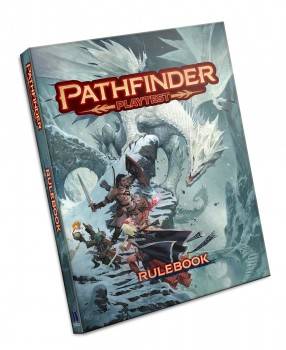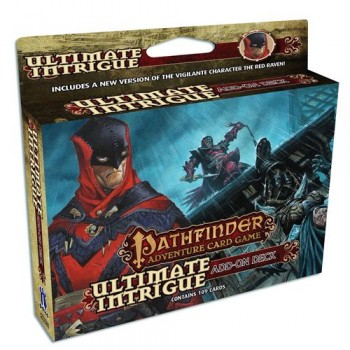Origins Game Fair: Pathfinder Society Organized Play
 Earlier this week, I spoke briefly about attending my first Origins Game Fair event in Columbus, OH, over last weekend, and about the Origins Awards they handed out for best game products of the year. But I wasn’t there for the awards, of course. I was there for the games themselves.
Earlier this week, I spoke briefly about attending my first Origins Game Fair event in Columbus, OH, over last weekend, and about the Origins Awards they handed out for best game products of the year. But I wasn’t there for the awards, of course. I was there for the games themselves.
Origins gave the one of the first real opportunities in the wild to see the upcoming Pathfinder Playtest in action. (It has previously been available at GaryCon, PaizoCon, and the UK Games Expo.) We have previously discussed the announcement by Paizo to release a public playtest at GenCon 2018 for their Second Edition, which will then release at GenCon 2019. Unfortunately for me, those events were fairly consistently sold out, and busy enough they didn’t want too many loiterers around the table to slow down the game for those actually playing. The tables were in a fairly accessible location, though, and the people playing seemed to be really enjoying themselves, but my attempt to get a glance at the character sheets were consistently thwarted. (I am signed up in one of the first Playtest slots at GenCon, though, so that I can provide feedback at that point.)
I’ve been following Paizo’s releases about the Pathfinder Playtest on their blog with interest, though, and was able to have a discussion with Paizo’s John Compton and Tonya Woldridge, to get some answers to the questions I had about how this would all play out … so to speak. John and Tonya are focused on the Pathfinder Society (and Starfinder Society) Organized Play program, so that’s where we spent the majority of our conversation. But before getting into the Organized Play questions, I wondered what to expect from a story-based perspective: Will Pathfinder Playtest (or Pathfinder 2nd Edition) come with a realm-shattering storyline?
Dungeons & Dragons has long incorporated these sorts of events with their narrative storylines, from the vanishing gods of Krynn in Dragonlance as it passes between ages to the Spellplagues and Sundering that corresponded with new editions of the basic Dungeons & Dragons rule set. White Wolf’s World of Darkness RPG setting back in the day similarly followed suit, with massive in-world transformations corresponding in particular to their release of their 3rd edition books.
Paizo isn’t planning anything so realm-shattering with Pathfinder 2nd Edition. The world will be updated, mostly to reflect the dramatic resolution of the plotlines from the various Adventure Path series. For example, the quest to battle the demonic Worldwound (from the Wrath of the Righteous Adventure Path) might be successful and the current War for the Crown Adventure Path will almost certainly transform the political landscape of the nation of Taldor. But the change in rule mechanics does not seem like it will fundamentally correspond to an in-world transformation in how magic functions.
The scenarios that are used within the Pathfinder Society Organized Play are also drawing to something of a resolution, so that players who have committed themselves to building characters over extended storylines can follow those storylines to a satisfying resolution before beginning new characters in the Pathfinder Playtest or Pathfinder 2nd Edition. The Playtest, which runs from August roughly through the end of the year, will be trackable within the Organized Play system, allowing GMs and players alike to earn some sort of Playtest Points for their playtesting experiences, as an added incentive to run through the Doomsday Dawn adventure … hopefully not just once, but multiple times. The goal of a playtest, of course, is for people to do their best to break the system. Then as Pathfinder 2nd Edition rolls out in fall of 2019, along with the 2nd edition Pathfinder Society Organized Play, these points for playtesting will be transferable into some sort of benefit within that organized play system. The details, of course, are unknown, since you can’t figure out what sorts of benefits are going to be fair and balanced while the rules themselves are still in flux.
In addition to a transformation of the Pathfinder RPG, there’s also transformation on the horizon for the Pathfinder Adventure Card Game, which has long been a favorite among several of us here at Black Gate. (See here, here, and here for previous coverage.) What I haven’t covered much is the Pathfinder Society Adventure Card Guild, the Organized Play element of this game, which I first got involved with at the 2017 GaryCon. The Guild play involves buying class decks that include a set of characters and assorted cards with which to build a deck. You then can take that set of cards to an Organized Play event and play it. The major difference between it and the standard play is that instead of keeping cards from among those you gain in the gameplay, you are essentially unlocking the option to have higher-level cards, and then you’ve got to select specific cards from among those you own in your class deck, which are usually thematically useful for your character class. The adventures for Organized Play are downloadable campaigns, built around seasons, that require the various Adventure Path base sets to play.
 There are a number of these class decks, allowing you to play anything from a variety of standard Fighter classes to more esoteric psychic classes based on Pathfinder Occult Adventures supplement. A couple of decks give you access to iconic Pathfinder goblin characters. More recent add-on decks have been added, based on supplements like Ultimate Magic and Ultimate Intrigue, which provide a single character card (the Arcanist and Vigilante, in the case of these two examples) and focus on providing a diverse set of cards that can be incorporated with existing class decks. In addition to be used in Organized Play, these class decks can also provide new characters to use with the base sets in standard play format.
There are a number of these class decks, allowing you to play anything from a variety of standard Fighter classes to more esoteric psychic classes based on Pathfinder Occult Adventures supplement. A couple of decks give you access to iconic Pathfinder goblin characters. More recent add-on decks have been added, based on supplements like Ultimate Magic and Ultimate Intrigue, which provide a single character card (the Arcanist and Vigilante, in the case of these two examples) and focus on providing a diverse set of cards that can be incorporated with existing class decks. In addition to be used in Organized Play, these class decks can also provide new characters to use with the base sets in standard play format.
But the big issue with the Organized Play Adventure Card Game as it exists today is that it still requires a major buy-in and recurring expenses, as running any given season of the game can only be done if you have purchased the appropriate base set. These are costly, and completing the entire campaign requires buying additional decks for the upper-level adventures. I own the first two sets, Rise of the Runelords and Skulls & Shackles, but couldn’t justify the expense of either Wrath of the Righteous or Mummy’s Mask, even though they looked like great games that I would have loved to have owned and played.
Upcoming changes to the Adventure Card game will mean that a single new Core Set will be needed, and then that set of basic cards will be fleshed out with smaller individual sets of cards. The initial buy-in and on-going investments to keep up with the game from season-to-season will be, at the very least, broken up over smaller increments. This was described by the ACG’s lead designer, Mike Selinker, earlier in the month over at the Paizo Blog. An exact timeline for these new releases is not yet available, and they aren’t showing up for preorder on Paizo.com … which is understandable, given their focus on getting the Pathfinder Playtest ready for GenCon.
Well, that coverage of the Paizo goodness went on rather longer than I expected, and I didn’t even get into the gangbuster “season finale” Starfinder Society adventure, The Scoured Stars Invasion. Guess you’ll just have to play that one yourself. But, in the meantimes, in my next installment I’ll discuss a few other game releases that may be of interest … particularly to those who aren’t so much into Organized Play.